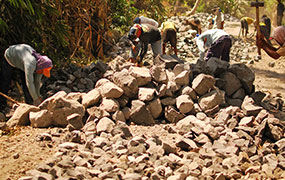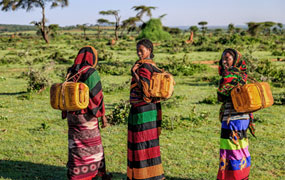to Livelihoods

This section investigates the gains to household welfare from speed and reliability and partitions this large body of research into empirical evidence and methodologies. Porter and White show that a rural safety net program in Ethiopia lessens a drought’s impact by 25 percent. The speed with which this safety net makes transfers, Berhane, Abey, and Hoddinott demonstrate, affects the benefits realized by individuals.
In a very different setting, de Janvry, Ramirez Ritchie, and Sadoulet find that when drought strikes, insurance payouts from the disaster risk finance program CADENA increase Mexican farmers’ income by 38 percent and their consumption by 27 percent.
But a financial instruments’ quality also determines the degree to which livelihoods and welfare improve. Taking agricultural index insurance as an example, Morsink, Clarke, and Mapfumo provide quantitative measures to answer two key questions: How well does the insurance insure what it set out to insure? And does the insurance really help reduce the income risk that poor households face? Jensen, Ikegami, and Mude examine two instruments well-suited to protect the livelihoods of pastoralists in northern Kenya—index insurance and scalable social protection—and discover both impact welfare positively.
Porter and White (2016) explain the power that probabilistic catastrophe (cat) risk models could have if applied to the assessment of household poverty outcomes. The authors argue that the challenge in applying cat risk models in this way is quantifying the relationship between hazard and outcome in a poverty context—the "vulnerability module" in a cat risk model. The authors attempt to derive such vulnerability relationships for the impact of drought on households in Ethiopia, asking whether a relationship can be derived between drought and household consumption that has internal and external validity and, if so, can help (1) model risk (in a probabilistic framework) and (2) understand the benefits of interventions, including early response.
Porter and White examine the impact of drought hazard on the welfare of rural households in Ethiopia using reductions in household consumption as their welfare indicator and crop-yield losses for drought. They use household income and consumption expenditure survey data as well as welfare monitoring surveys for 2005 and 2011 to provide representative cross-sectional data for rural Ethiopia, including household characteristics, consumption outcomes, and measures of realized shocks such as illness and unemployment. A view of drought hazard is taken from the World Food Programme's Livelihood Early Assessment and Protection (LEAP) data, a drought measure showing expected community crop losses based on water adequacy specific to the respective crops.
A regression model is defined, in which the outcome of interest is the log of household consumption per adult, to be examined against drought in the context of other household/community characteristics. The authors consider that the consumption-drought relationship will be attenuated by certain household and community characteristics: access to coping strategies (such as education); the occurrence of other shocks (such as illness); and access to institutional coping strategies (such as public safety nets). These factors are examined explicitly within the model. The results are then tested for robustness using Statistical Learning Methods to infer applicability of the derived relationships within a cat risk modelling framework.
According to the regression results, the impact of drought (represented as the LEAP drought variable) is significant across all models examined, with the baseline result showing that for every 10 percent worsening of the LEAP drought variable, consumption falls on average by 1.5 percent. The other models typically show about a 2 percent fall in consumption per 10 percent drought worsening. The results also reveal that access to a safety net (Ethiopia’s Public Safety Net Programme, PSNP) mitigates the drought impact by 0.5 percent—that is, households with PSNP access experience a 1.5 percent decrease in consumption rather than a 2 percent decrease. The results of the Statistical Learning exercise suggest that the relationship between drought and consumption is fairly homogeneous and stable, leading Porter and White to conclude (with caveats) that the derived drought-poverty relationship demonstrates some level of external and internal validity. Therefore, this relationship could form the basis of a vulnerability module in a catastrophe risk model.

Guush Berhane, International Food Policy Research Institute
Mehari Hiluf Abay, International Food Policy Research Institute
John Hoddinott, Cornell University
 |
The Government of Ethiopia has developed and implemented its Productive Safety Net Programme (PSNP), covering nearly 8 million Ethiopians. Beneficiary households can engage in public works in the months when labor is slack in return for income designed to increase the food security of households during the lean season. The program also scales up in times of disaster.
Berhane, Abay, and Hoddinott (2016) look at whether increasing the ability to provide more timely support to beneficiaries has an impact on welfare. They examine the relationship between the existing variation in the timing of payments to PSNP public works beneficiaries and poverty outcomes. In doing so, they focus on household consumption, child-level nutrition, and schooling outcomes, across four main regions that have implemented the PSNP since 2005.
The PSNP makes monthly payments for work conducted and is designed to provide income to households in advance of the lean season. However, actual implementation varies by region and over time: 57 percent of public works participants reported no delay; 27 percent, a small delay of one or two months; and 16 percent, a delay of three months or more. Very few payments are delayed by more than four months, and once monthly payments are started, they are likely to continue smoothly.
When payments are delayed prior to the start of the lean season (June-September for most of Ethiopia's highlands), household consumption and nutrition are negatively affected. Delayed payments reduce the household consumption expenditure, although the observed effect is weak. In addition, delayed payments reduce agricultural income—perhaps because the households who do not receive timely payments are forced to sell their crops when prices are at their lowest. Finally, payment delays are also found to increase the probability that children of primary school age will drop out of school, and therefore the delays decrease educational attainment. These negative welfare effects of payment delays are more pronounced when delays are preceded by bad harvests in the previous season. Conversely, payments delayed well into and made in lump sum during the lean season are observed to have strong positive (unintended) effects on other welfare outcomes, mainly non-food expenditures, ownership and total value of livestock owned, value of productive assets owned, food gap, and net private transfers. These latter effects suggest the lumpy structure of delayed payments likely has an investment role albeit at the cost of lost welfare in terms of consumption, nutrition, and schooling during the public works months.
In sum, the timing of the payment does affect its welfare effect, suggesting that if payments to households in need become more timely (that is, arrive in advance of the lean season), they would have a larger impact on welfare. The findings also suggest that delayed lump sum payments in the lean season may result in unintended positive effects on some outcomes that should be weighed against the welfare losses in the months they are meant to be paid.
 |

|
Drechsler and Soer (2016) examine how Ethiopia's early warning system could be used to enable early action to respond to drought. They find three clearly defined, transparent, and complementary systems that are already in place: the Livelihood Early Assessment and Protection (LEAP) tool monitors food security among the rural population using a water index; the Livelihood Impact Assessment Sheet (LIAS) captures bottom-up information on local livelihoods and markets; and ad-hoc and hotspot assessments identify deteriorating food security situations. These tools, when used together, could inform early response.
Early response to drought is crucial in protecting lives and livelihoods while saving costs. Response through the humanitarian system requires fundraising and can take up to eight months. In contrast, response using early warning data triggers contingency financing and can respond in as little as two months-four times faster.
By using the three tools' intermediate and final outputs effectively, LEAP, LIAS, and hotspot assessments could be used to detect the onset of a drought and the need to respond. Moreover, as each tool is based on a different methodology, it is possible to compare drought predictions to obtain a more accurate view of the severity of a drought.
LEAP, based on a basket of primary crops in a geographic area, estimates the number of people in need of food assistance based on the Water Requirements Satisfaction Index (WRSI). In the process of computing beneficiary numbers, the LEAP tool computes three intermediary outputs: planting dates, WRSI and yield reduction estimates. By combining the WRSI, past beneficiary numbers, and demographic data, the LEAP tool estimates beneficiary numbers.
LIAS employs a risk-modeled Household Economy Approach (HEA). Its components zone livelihood and market systems geographically; set wealth categories within the zones; calculate the average cash income and food intake for each wealth category (baseline); model the impact of droughts on livelihood baselines; analyze coping capacities; and estimate beneficiary numbers according to livelihood viability and collapse under duress.
Hotspot and ad-hoc assessments deploy uniform food security and nutritional criteria to ensure comparability across regions. Quarterly, they prioritize the use of scarce resources to enable targeted supplementary feedings with the support of woreda health workers and offices.
These instruments, Drechsler and Soer conclude, could represent the building blocks of a well-functioning early action framework. Ethiopia has consistently extended LEAP and LIAS, producing more and better data and further improving their predictive powers.
Agricultural index insurance has become a common risk management instrument for low-income farmers. For index insurance, payouts correlate with the performance of an index, not actual losses. An imperfect correlation—basis risk—means the index may pay out when no losses occur and may not pay out when losses do occur. The impact on poverty is thus highly sensitive to the reliability of the coverage. Until now, the lack of an operational and measurable definition of basis risk and the underutilization of appropriate statistical techniques have precluded monitoring this reliability.
Morsink, Clarke, and Mapfumo (2016) discuss the reliability of index insurance and propose monitoring indicators that, with basic technical knowledge, can be applied by donors, governments, and insurers to any context in which payouts are based on indices correlated with losses.
Establishing whether index insurance reliably protects low-income individuals against losses from agricultural production requires answering two key questions:
Morsink et al. devise two indicators to measure insured-peril and production-smoothing basis risk and thus the reliability of index insurance. The first, the probability of catastrophic basis risk, assesses the probability of not receiving a claim payout when a farmer has catastrophic losses in agricultural production. The second, the catastrophic performance ratio, measures what a farmer receives relative to the premium paid when the farmer experiences catastrophic losses.
These indicators are simple to calculate and easy to understand, providing proxies for the reliability of indexed protection. They can be used to compare agricultural insurance products against a benchmark, to one another, and over time, and to calculate the cost and effectiveness of alternative disaster risk finance instruments. They provide invaluable inputs for disaster risk finance strategies, while improving the quality of products, better protecting consumers, and reducing reputational risk.

Nathaniel Jensen, Cornell University
Munenobu Ikegami, International Livestock Research Institute
Andrew Mude, International Livestock Research Institute
 |
Social safety nets are an important tool used by policy makers to support and protect their constituents. Recently, there has been a push to increase the sophistication of the targeting mechanisms and to combine multiple protection tools to improve the efficiency of these programs. This effort is motivated by the recurring humanitarian interventions in regions that have existing social protection programs.
Although a number of countries have or are planning to implement integrated social protection programs, there is little existing empirical evidence on the welfare outcomes from these programs. Not only might the added logistical burden of implementation offset potential gains, but it is still not clear that welfare dynamics are sufficiently homogeneous to make sophisticated targeting around specific inflection points in wealth a realistic objective.
Jensen, Ikegami, and Mude (2016) examine how to develop evidence-based policy recommendations by studying the impacts of various social protection programs on poverty. They test whether there are poverty benefits to using an integrated approach to social protection, providing differential programs for the ultra-poor and those who are less poor but still vulnerable. Of particular interest is the use of cash to help the poorest and the use of insurance to protect the vulnerable from falling into poverty during large shocks. They also examine other policy-relevant questions, including the benefits of insurance transfers versus insurance subsidies and the extensive scaling of cash transfers conditional on environmental conditions.
Kenya, which is currently implementing a set of social protection schemes, offers an excellent opportunity to study the effects of different protection strategies and simulate the welfare and fiscal gains of integration. The authors use data from five annual rounds of panel household survey data and instrumental variables to identify the observed impacts of a cash transfer program, the Hunger Safety Net Program, and insurance, the Index Based Livestock Insurance (IBLI) product, on pastoralist households in northern Kenya. Those parameter estimates are then used to simulate the impacts of a menu of hypothetical social protection policies, which would each have the same cost.
Jensen et al. find for the most part very few differences in the poverty outcomes associated with the various targeted approaches. Although this apparent ambiguity may seem disappointing, it frees policy makers to develop their social protection strategies with additional objectives in mind—for example, to pursue strategies with the lowest overhead or to support the development of a robust insurance market.
This study is not without its own shortcomings, which the authors discuss and use to highlight the need for further research.
 |

|
Few tools have been successfully implemented at scale that enable the rural poor to manage the risks of weather shocks and to cope in their aftermath. Mexico is an exception. Its government pioneered a weather index insurance program in 2003 that by 2013 insured more than 6 million hectares of cropland. CADENA grew from a drought index insurance for maize in one state to a near-national insurance program for many perils and crops.
De Janvry, Ramirez Ritchie, and Sadoulet (2016), recognizing the expansive coverage and tenure of the CADENA program, use the unique setting to evaluate index insurance's effects on ex post production decisions and coping mechanisms. They focus on the program's largest component historically, drought index insurance.
CADENA insures farmers growing staple crops on less than 20 hectares of rain-fed land. If precipitation as measured by the corresponding weather station falls below the designated threshold in any of the three phases, the insurer makes a payment to the state. The state then transfers payments to eligible farmers in the insured area in time for the next growing season. Overall, results comparing municipalities that receive payments with those that do not show that the federal government-funded program helps sustain rural livelihoods, mitigating the losses from drought without the need to assess individual damage. Another finding was that farmers in municipalities that receive insurance payments increase the hectares sowed of insured crops by about 17 percent relative to those in municipalities that do not receive payments.
The impact of drought index insurance when comparing a municipality that receives no payment with one that receives payment is an increase of about 27 percent in expenditure per capita and 38 percent in income per capita. This increase corresponds to about 6,000-8,000 pesos in additional income. However, results suggest that the insurance transfer induces a reduction in remittances sent by migrants, lowering the net income effect of the payouts.
Turning to the cost side, premium payments exceed indemnity payments in all but two years, resulting in an overall loading factor of 73 percent. Although these results suggest that the cost of insurance is high relative to the payouts received, a cost-benefit analysis using the increase in household income implied by the regression estimates finds that the benefits of the program exceed the costs for a wide range of estimates. Moreover, CADENA, by design, makes government expenditures more predictable and disciplines the responses of state governments to weather shocks. Recognizing these benefits, the federal government provides subsidies of up to 90 percent for CADENA while simultaneously increasing the required contributions of uninsured states seeking funds for ex post relief.